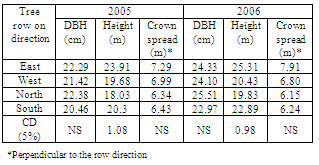-
Paper Information
- Next Paper
- Previous Paper
- Paper Submission
-
Journal Information
- About This Journal
- Editorial Board
- Current Issue
- Archive
- Author Guidelines
- Contact Us
International Journal of Agriculture and Forestry
p-ISSN: 2165-882X e-ISSN: 2165-8846
2012; 2(5): 239-246
doi: 10.5923/j.ijaf.20120205.07
Evaluation of Poplar (Populus deltoides Bartr. Ex Marsh.) Boundary Plantation Based Agri-silvicultural System for Wheat-Paddy Yield and Carbon Storage
S. K. Chauhan 1, R. Sharma 1, S.C. Sharma 2, Naveen Gupta 3, Ritu 1
1Department of Forestry and Natural Resources, Punjab Agricultural University, Ludhiana ,141 004 ,India
2RRSKA Ballowal Saunkhri, SBS Nagar, India
3Dept. of Soils, Punjab Agricultural University, Ludhiana, 141 004, India
Correspondence to: S. K. Chauhan , Department of Forestry and Natural Resources, Punjab Agricultural University, Ludhiana ,141 004 ,India.
| Email: |  |
Copyright © 2012 Scientific & Academic Publishing. All Rights Reserved.
Wheat and paddy (rice) yield was accessed with respect to aspect as well as distance from the base of poplar tree lines in all the four directions. Wheat and paddy yield was found maximum on Southern aspect (4.11t/ha and 5.06 t/ha, respectively), whereas, it was found minimum on Northern aspect (2.5 t/ha and 4.13 t/ha, respectively). Distance from tree base also played significant role on the yield of grain crops. The yield of wheat as well as paddy increased with the increase in distance from the boundary tree lines. Crop yield increased with increase in distance from 2m to 10 m distance from the poplar trees (wheat:2.85 t/ha to 3.63 t/ha and paddy:3.22 t/ha to 5.66 t/ha). However, in control conditions wheat and paddy yield was 4.47 t/ha and 6.96 t/ha, respectively. There was a decrease of 33.75 and 36.15 per cent in paddy and 26.68 and 25.69 per cent in wheat under 5th and 6th year old poplar boundary plantation than the control. Soil parameters (organic carbon, total nitrogen, Available P and K) were also accessed to quantify the effect of this system on nutrients on all the four directions along with the carbon storage in the biomass, which were significantly influenced by the poplar plantation.
Keywords: Agroforestry, Poplar, Boundary Plantation, Rice-wheat Rotation, Carbon Sequestration
Article Outline
1. Introduction
- Wheat-Paddy (rice) cropping systems are of immense importance for food security in South Asian countries including India, providing, for example, 85 per cent of the total cereal production and 60 per cent of the total calorie intake[1,2]. The traditional rotation system though profitable has not remained sustainable as it has resulted in lowering ground water table, development of compact sub-soil layer and nutrient imbalance. It has also put a stigma on the sustainability of future agriculture and ecological balance[3]. Thus, necessitating the diversification in this traditional crop rotation.Trees under agroforestry besides providing the tree products, improves soil productivity through ecological and physico-chemical changes. Populus deltoides based agroforestry system is one of the viable alternate land use system to prevent further degradation and obtain biological production on sustainable basis in the irrigated agro-ecosystem. Owing to its fast growth, deciduous nature, marketing acceptability and successful intercropping, poplar cultivation has become popular among the farmers as a viable alternative to wheat-paddy rotation in north-western states of India. Poplar being a deciduous tree enters in dormancy during winter, therefore suited well to companion crop for ensuring food production and also enhance economic returns to the growers. This species has been grown by farmers as boundary or block plantation, which This improves the physico-chemical properties of soil through addition of organic matter in the soil[4,5] and provides alternate sources of income and employment to the rural poor[6,7]. However, some adverse effects have also been reported by various workers[8-11]. Leaf-fall at sowing poses physical barrier to seed germination and may affect the availability of nutrients/light to developing seedlings but addition of leaves changes the C: N ratio of the soil, which also influence the crop growth[5]. Poplar being sensitive to water logging is unsuitable under rice based cropping system, but boundary plantation of poplar might be an option to continue traditional rotation of rice-wheat for the farmers who seem reluctant to leave the rotation because of assured market/minimum support price of the crops. Moreover, the small farmers cannot afford to raise block plantation at the cost of agricultural crop yield. A large scale area is already under poplar boundary plantation in Punjab and adjoining states[12,13]. In a recent study on tree growing on farm land of 250 villages of Punjab, a ratio of 1:3 in block to bund plantations of the poplar has been recorded[14]. There has been no attempt to quantify the wheat-paddy yield and carbon sequestration potential of poplar boundary plantation. The present study was an attempt to determine the effect of Populus deltoides on the yield of rice-wheat and carbon assimilation through poplar based silvo-arable system.
2. Material and Methods
- Paddy-wheat is the most dominant crop rotation of irrigated agriculture in north-western states of India. Effect of poplar boundary plantation was quantified to access the potential of this agroforestry system for crop yield productivity and carbon storage/assimilation. A field experiment was conducted during 2004-2006 on the farmers’ field at Balachaur, SBS Nagar, Punjab, India (316’5”N and 7623’26’E at 355 m above the mean sea level). The site is characterized by sub-tropical to tropical climate with hot and dry summers from April to June, hot and humid from July to September and cold winter from December to January. The average annual rainfall during 2004-06 was 571 mm, which was more or less equal to the normal in the region (586 mm). The experimental soil was sandy loam (0-15 cm) in texture. The soil was found slightly alkaline in reaction and low in organic carbon, low in alkaline KMnO4-extractable N, medium in 0.5N NaHCO3-extractable P and medium in NH4OAc-extractable K.
2.1. Experimental Background
- The experiment was started in 2004 with paddy crop followed by wheat for two years. The field was dry tilled once with discs plough and twice with cultivator and levelled with a wooden plank. The plots to be puddled were surrounded by bunds of 15-20 cm height and flooded with 5-7 cm of water. Puddling was done with tractor. About one month old seedlings of Pusa-44 were transplanted manually. The field was kept submerged till 15 days before the harvest of the crop. The crop was harvested with combine harvester in October and wheat (PBW 343) was sown with seed drill at a row to row distance of 22.5 cm in the first week of November. All recommended practices of Punjab Agricultural University, Ludhiana (India) for crop cultivation were followed. The crop was harvested in April. One year old poplar plants of G- 48 clones were transplanted in January, 2002 on the boundary of 196x75m2 plot at a distance of 2.5 m (160 trees/ha). There was no other special management practices followed for poplar except pruning of the tree from second year.
2.2. Trees Data
- The trees at random on all the four directions were measured for their top height, diameter at breast height (DBH) and crown spread. The total height was measured with Multimeter (in metres) from ground to top of the trees. The diameter at breast height (1.37 m above the ground level) was taken with the help of digital calliper. Precautions were taken that the point of measurement was clean and clear, knots or any other abnormality at 1.37 m was avoided and diameter was recorded at slightly higher or lower points as convenient. Crown spread was measured using metre tape and two poles holding straight touching to the outmost tip of the opposite sides of tree at perpendicular to the row direction. The distance between these two poles were recorded with the help of measuring tape. Leaf-fall data was recorded in the month of January (1x1m2 quadrat) at an interval of 2m upto 10m from the tree line on all the directions. The poplar tree height was significantly variable on different sides, through DBH and canopy spread were at par on all the directions (Table 1).
|
2.3. Grain Yield
- The each direction of the field was divided into three equal parts and each part was considered as a replication leaving 20m distance at the corners to avoid dual direction effect. The grain yields were recorded from 1 m2 area at 2, 4, 6, 8 and 10 m distance from the base of the poplar trees on each direction and grain yield was extrapolated to be expressed in t ha-1 by bringing the produce at 14 per cent grain moisture content.
2.4. Carbon Storage
- The randomly collected plant samples (wheat/paddy/poplar) were analysed for C content. The carbon content in different plant components (above and below ground) was estimated on CHNS analyser to calculate the carbon storage in each component of poplar (stem, branch, bark, leaves and root) and crops. The total carbon storage was computed by using the carbon values of respective component and multiplying the same with the biomass of each component derived through the regression equations developed in prevailing conditions[15]. These values were further extrapolated on hectare basis by multiplying with standing biomass per hectare. The soil samples were collected from all the four directions at variable distances (2, 4, 6, 8 and 10 m) from the tree lines and centre of the field at 0-15, 15-30 and 30-60 cm depths. Soil was analysed for carbon, total nitrogen, available P & K. The results of net carbon accumulation in the tree components have been determined to substantiate the environmental benefits of tree planting on agricultural land. The data on growth, biomass, carbon allocation in poplar and wheat were statistically analysed after following the established procedures[16]. Significant differences between treatments (age of poplar plantations and sole crop with four replicates) means for growth, biomass and carbon storage were tested at p ≤ 0.05 using least significant difference test.
3. Results and Discussion
3.1. Crop yield
- Poplar boundary plantation of five and six years age were assessed for their effect on the intercrops (paddy and wheat). Aspect as well as distance from the boundary had significant effect on the grain yield of wheat and paddy (Fig. 1). The visual observations made for rice and wheat crop growing with poplar as boundary plantation revealed that the growth of the crop plants were poor as we moved towards the poplar tree line in each direction from the centre of the field. The establishment of crop was poor near the tree line. This resulted in overall decline in the rice –wheat crop yield near the plantation line. During both the years, the trend of crop behaviour was same with respect to direction and distance from poplar rows. There was a decline of nearly 33.75 and 36.15 per cent in paddy and 26.68 and 25.69 per cent in wheat during 2004-05 and 2005-06, respectively. The reduction in paddy yield was more than the wheat yield reduction. No study on paddy with poplar has been carried out earlier though there are studies on wheat crop.
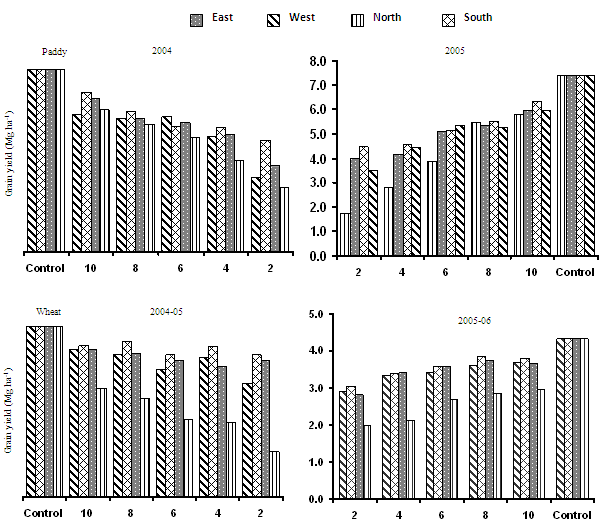 | Figure 1. Performance of paddy-wheat rotation under poplar boundary plantations |
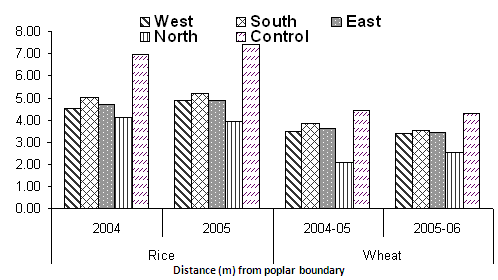 | Figure 2. Effect of boundary plantation of poplar on grain yield (Mg ha-1) of rice and wheat |
3.2. Soil Organic Carbon and Other Chemical Properties
- Trees in association with agricultural crops increase the soil carbon status, though the changes depend upon the quality and quantity of litter input, decomposition rate and carbon release. The changes in micro-environment under tree canopy (soil moisture, temperature, etc.), proliferation of root system and enhanced biological activity also favour the carbon stock in the soil. However, the continuity in the system is essential; otherwise the build-up in organic carbon may revert back to its original under commercial agriculture. A decreasing trend in soil organic carbon (SOC) was observed with soil depth in all the poplar plantations and plots without poplar trees. It was low in control plot compared to the spots near the tree line on all the four directions of poplar plantations at three soil depths (Fig. 3). There was a decreasing trend in SOC as we move away from the poplar boundary line. The differences in SOC were observed with different directional aspects also. The SOC was higher in northern and southern row directions than the eastern and western directions, however, the control plots had minimum SOC. The increase organic build-up in the top layer near the tree lines was due to the addition of litter, pruning material and tree roots. Similar observations were reported earlier also[5,21,26,27]. On account of recycling of organic matter, higher organic carbon was observed in soil under intercropping poplar plantation than a site without trees[28]. 65-88 per cent higher soil organic carbon stock in agroforestry system than rice-wheat system have been recorded earlier[29], even hot water soluble and microbial carbon have also been reported higher in poplar based agroforestry system than rice-wheat rotation. Addition of leaf litter (dry wt) in 1m2 quadrat with respect to the row directions and distances from the boundary plantation revealed significantly different values on all the directions and distances. Maximum leaf litter (195.05 gm) was recorded on western row direction, whereas, minimum (41.04 gm) on eastern side. It reduced gradually from 197.08 gm at 2m distance from boundary to 62.83 gm at 10 m distance from the boundary. Maximum value (247.58 gm) was on the western direction at 2m distance from the boundary, whereas, minimum value (12.58 gm) on eastern row direction at 10 m distance (Table 2). The lower litter on the south-eastern row directions and higher on the north-western direction indicated that the wind direction was north-western to south-eastern during the leaf shedding period, which is normal direction during the winters in this part of the country. This has also been reflected in the leaf shedding pattern.
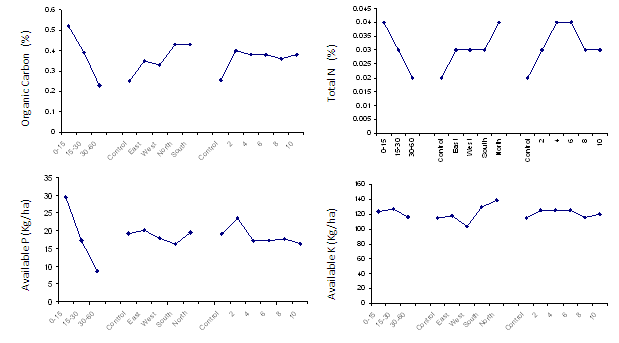 | Figure 3. Soil nutrient status on all the four directions (east, west, north & south) and control in poplar boundary plantation at different distances from tree rows (2,4,6,8 & 10m) and depths (0-15, 15-30 & 30-60cm) |
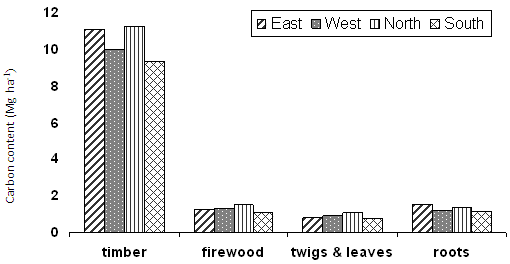 | Figure 4. Carbon storage in different poplar tree components at different directions |
3.3. Carbon Storage
- The carbon concentration in timber, roots, firewood and twigs + leaves was estimated to be 45.67, 47.82, 46.56 and 45.50 per cent, respectively. The biomass estimates revealed that all tree components varied in terms of carbon stock among themselves (Fig. 4). The stem contributed 74.78 per cent carbon followed by roots (10.31 %), firewood (9.04 %) and twigs + leaves (5.87%). The stem wood mentioned here still contains about 10-15 per cent of wood, which will not go to durable products but as fuel wood (lops and tops/wastage from industries, etc.).The carbon stock in different carbon pools under study indicated that vegetation stock i.e., above-ground biomass contributed the maximum towards aggregate carbon pool under agroforestry system. The litter combined with roots contributed the least towards the aggregate C-stock, which was almost negligible in comparison to other pools. The incremental carbon potential, however, depends upon the productivity of the components (poplar and wheat-paddy here). Average carbon sequestration potential in agroforestry in India has been estimated to be 25t/ha over 96 million hectares[31] but there is considerable variation in different regions depending upon the biomass production[32]. Variable carbon sequestration figures have been reported in poplar based systems as well[12,33-35], which are dependent upon tree geometry, clones used, site factors, management aspects, etc.
4. Conclusions
- The above results revealed that the losses to both the crops were significantly higher with increasing tree canopy depth towards tree rows. The growth and yield of crops increased progressively as the distance from tree line increases. These results clearly indicated that the crop raised on northern and eastern aspect showed poor performance in terms of their growth and yield than southern and western aspect. Therefore, for boundary plantation, the tree rows should be preferred in the order of north, east, west and south direction of the farm. The system has huge potential for carbon storage in biomass as well as in soil. Poplar based agroforestry has contributed substantially to the ecological, economic and social function, resultantly farmers are extensively adopting the poplar-crop combination to diversify the traditional rice-wheat crop rotation, thus increasing the tree cover as well.
ACKNOWLEDGEMENTS
- Authors are thankful to the Indian Council of Agricultural Research, New Delhi (India) for providing the financial support for conducting the investigations. The support of Sh. O.P. Chaudhary, Progressive Farmer, Balachaur (SBS Nagar, Punjab, India) is also gratefully acknowledged.
References
| [1] | J. Timsina, D.J. Connor, Productivity and management of rice-wheat cropping systems: issues and challenges. Field Crops Research, 69(2001) 93-132. |
| [2] | R.K. Gupta, R.K. Naresh, P.R. Hobbs, J. Zheng, J.K. Ladha, Sustainability of post-green revolution agriculture: the rice-wheat cropping systems of the Indo-Gangetic Plains and China. In: Improving the Productivity and Sustainability of Rice-Wheat Systems: Issues and Impacts (Eds. Ladha, J.K., Hill, J.E., Duxbury, J..M., Gupta, R.K. and Buresh, R.J.) ASA Special Publication 65 (ASAInc, CSSAInc, SSSAInc, Madison, USA), (2002) pp.1-25. |
| [3] | P. S. Sidhu, Farmers and Farming in Punjab. Proceedings of brain storming meeting. Oct. 23-24, 2008 at PAU, Ludhiana, (1998) 36p. |
| [4] | M.D. Coleman, J.G. Isebrands, D.N. Tolsted, V.R. Tolbert, Comparing soil carbon of short rotation poplar plantations with agricultural crops and woodlots in north central United States. Environmental Management, 33(2004) 299-308. |
| [5] | B. Singh, K.N. Sharma, Tree growth and nutrient status of soil in a poplar (Populus deltoides Bartr) based agroforestry system in Punjab, India. Agroforestry Systems, 70(2007) 125-134. |
| [6] | K. Balooni, Economics of wasteland afforestation in India, A review. New Forests, 26(2003) 101-136. |
| [7] | S. Puri, P.K.R. Nair, Agroforestry research for development in India: 25 years of experiences of a national program. Agroforestry Systems, 61-62(2004) 437-452. |
| [8] | R.K. Kholi, H.P. Singh, D.R. Batish, Phytotoxic potential of Populus deltoides Bartr. Ex Marsh I. Comparative contribution of different parts. Indian Journal of Forestry, 20 (1997) 300-304. |
| [9] | R. K. Kohli, D. Batish, H.P. Singh, Performance of some winter season crops under Populus deltoides in a simultaneous agroforestry system. In: Proc. IUFRO-DNAES International Meet on Resource Inventory Techniques to Support Agroforestry and Environment Activities. (Eds. R.K. Kohli, K.S. Arya) DAV College, Chandigarh, India, (1996) pp. 187-190. |
| [10] | H.P. Singh, R.K. Kohli, D.R. Batish, Allelopathic interference of Populus deltoides with some winter season crops. Agronomie, 21(2001) 139-146. |
| [11] | D.P.S. Nandal, A. Dhillon, Allelopathic effect of poplar (Populus deltoides Bartr. Ex Marsh): An assessment on the response of wheat varieties under laboratory and field conditions. Indian Journal of Agroforestry, 9(2007) 125-127. |
| [12] | M. Gera, G. Mohan, N.S. Bisht, N. Gera, Carbon sequestration potential under agroforestry in Roopnagar District of Punjab. Indian Forester, 132(2006) 543-555. |
| [13] | Anonymous, Report on inventory of trees outside forests (TOF) in Punjab. First Survey of India, Dehradun (2006). 142p. |
| [14] | Anonymous, Studies on interrelationship between production levels and marketing of important forestry species of Punjab. Project Report submitted by RS and M Division, FRI Dehradun, 2007. |
| [15] | S.C. Sharma, A.S. Dogra, A. Upadhayay and G.S. Chahal, Carbon stock and productivity assessment of Populus deltoides Bartr. Ex Marsh in Punjab. Indian Forester, 133 (2007) 8-16. |
| [16] | K.A. Gomez, A.A. Gomez, Statistical procedures for agricultural research (2nd ed.). John Wiley & Sons, Inc. New York. (1984) 680p. |
| [17] | N.K. Sharma, H.P. Singh, K.S. Dhadwal, Effect of poplar (Populus deltoides) on wheat growth at an early stage. Indian Journal of Soil Conservation, 28(2000) 221-225. |
| [18] | N.K. Sharma, K.S. Dhadwal, Growth and yield of wheat as affected by boundary plantation of Populus deltoides M. in western Uttar Pradesh. Indian Forester, 133(2007) 899-908. |
| [19] | P.J. Burgess, W. Stephen, G. Anderson, J. Durston, Water use by a poplar wheat agroforestry system. Vegetation management in forestry, amenity and conservation areas: managing for multiple objectives, 19-20 March, 1996 University of York, UK. Aspects of Applied Biology, 44(1996) 129-136. |
| [20] | K.K. Sharma, R.K. Singh, Studies on tree crop interaction in Populus deltoides ‘G-3’ boundary plantation under irrigated conditions. Indian Forester, 118(1992) 102-108. |
| [21] | H.P. Singh, R.K. Kohli, D.R.Batish, Effect of poplar (Populus deltoides) shelterbelt on the growth and yield of wheat in Punjab, India. Agroforestry Systems, 40 (1998) 207-213. |
| [22] | A. Raizada, Biomass structure, leaf fall, litter decomposition and nutrient dynamics in Poplar (Populus deltoides M.). Ph.D. Dissertation, Dept. of Botany, DAV College Dehradun, 1988. |
| [23] | V.N. Tandon, M.C. Pandey, H.S. Rawat, D.C.Sharma, Organic productivity and mineral cycling in plantation of Populus deltoides in Tarai region of U.P. Indian Forester, 117(1991) 596-608. |
| [24] | P. K. Ralhan, S.Z.A.Rasool, A. Singh, Return of nutrients through leaf litter of a age series of poplar plantations in agri- silviculture system in certain parts of Punjab. In: Proc. IUFRO-DNAES International Meet on Resource Inventory Techniques to Support Agroforestry and Environment Activities. (Eds. R.K. Kohli, K.S. Arya) DAV College, Chandigarh, India. (1996), pp.159-163. |
| [25] | F. Mohsin, R.P. Singh, K. Singh, Magnitude of re-translocation of N,P,K in Populus deltoides intercropped with aromatic crop. Annals of Forestry, 7(1999) 254-262. |
| [26] | G. Singh, Carbon sequestration under an agri-silvicultural system in the arid region. Indian Forester, 131(2005) 543-552. |
| [27] | M. Peichl, N.V. Thevathasan, A.M. Gordon, J. Huss, R.A. Abohassan, Carbon sequestration potential in temperate tree-based intercropping system, southern Ontario, Canada. Agroforestry Systems, 66(2006) 243-257. |
| [28] | K.Singh, S.S. Chauhan, D.K. Rajput, D.V. Singh, Report of a 60 month study on litter production, change in soil chemical properties and productivity under poplar (Populus deltoides) and eucalyptus (Eucalyptus hybrid) inter planted with aromatic grass. Agroforestry Systems, 9(1989) 37-45. |
| [29] | D.K. Benbi, Kiranbir Kaur, A.S. Toor, Pritpal Singh, Hargopal Singh, Soil carbon pools under poplar-based agroforestry, rice-wheat, and maize-wheat cropping systems in semi-arid India. Nutrient Cycling and Agroecosystem 92(2012) 107-118. |
| [30] | P.K.R. Nair, V.D. Nair, B. Mohan Kumar, J.M. Showalter, Carbon sequestration in agroforestry systems. Advances in Agronomy, 108(2010) 237-307. |
| [31] | J.S. Sathaye, N.H. Raviderdranath, Climate change mitigation in the energy and forestry sectors of developing countries. Annual Review of Energy and Environment, 23(1998) 387-437. |
| [32] | D.P. Pandey, Multifunctional agroforestry systems in India. Current Science, 92(2007) 455-463. |
| [33] | S.K. Chauhan, S.C. Sharma, R. Chauhan, N. Gupta, Ritu, Accounting poplar and wheat productivity for carbon sequestration agri-silvicultural system. Indian Forester, 136(2010) 1174-1182. |
| [34] | S.K. Chauhan, N. Gupta, R. Walia, S. Yadav, R. Chauhan, P.S. Mangat, Biomass and carbon sequestration potential of poplar-wheat inter-cropping system in irrigated agro-ecosystem in India. Journal of Agricultural Sciences and Technology A, 1(2011) 575-586. |
| [35] | R.H. Rizvi, S.K. Dhyani, R.S. Yadav, Ramesh Singh, Biomass production and carbon stock of poplar agroforestry systems in Yamunanagar and Saharanpur districts of northwestern India. Current Science, 100(2011) 736-742. |
 Abstract
Abstract Reference
Reference Full-Text PDF
Full-Text PDF Full-Text HTML
Full-Text HTML